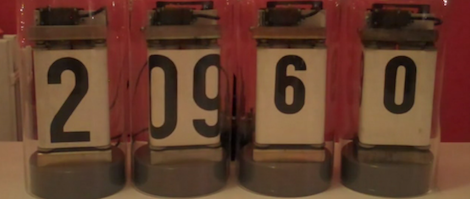
A long time ago and on a scrounging trip he barely remembers, [Victor] bought a quartet of digits from an old Dutch Railways clock. These antique displays used a strip of plastic coated cloth that rolls around itself with the help of a motor to display the digits 0 through 9. It’s been many years, but [Victor] finally got around to building a clock out of these single digit displays and we’re loving the results.
Because these displays were manufactured in a time when mechanical devices were king, [Victor] had to slightly modify each digit so they could display numbers with the help of a continuous rotation servo. The four servos are controlled by an Arduino – each digit changing one at a time to reduce current consumption – and a magnet and reed switch was added to each digit so the numbers could be repeatedly displayed.
Before [Victor] replaced the plastic servo gears with metal cogs, the clock was quite noisy. He’s since put each digit underneath a bell jar (actually a vase turned upside down), and we’ve got to say that [Victor] has a nice clock on his hands. Check out the videos of the clock changing digits to display the time after the break.
[vimeo=34147462]
[vimeo=37557095]















It looks nice but it really shits the bed at midnight! Transition time is always a huge issue with these art clocks.
Yeah, I really hate shitting clocks. There’s the mess to clean up, and you can never get the smell to go away completely…
I prefer the urinating ones.
This is a cool clock. I think it could be greatly improved, both speed and noise-wise, by using decent motors. As for the demo, I kept struggling to understand what part of time numbers like “2960” represent: is it 29 hours 60 minutes or 29th of 60?
i would have used a geared stepper my self by still impressive!
I hate metric tine. 29:60 is hard to remember that it’s 4:32am
Every device can display one digit from 0 to 9.
When it’s changing time at 23:59 the clock needs to change every digit to its new value of 0, and it says in the video that only one digit can move at a time to minimize power drain.
That’s why during the transition the clock shows 29:60. The second digit will reach 0 at the next pass, and the 3rd still has to go through 7, 8 and 9.
There is no such thing as ‘metric’ time. Only 24 hour format (that makes a lot more sense than the 12:00 am/pm format IMHO).
As always, all the answers are in the article and/or the videos. Please read before you hit the “Submit Comment” button.
You must be new here.
Although the 24 hour format only exists on paper. When the clock reads 20:00 it’s still “eight”.
Oh really?
http://zapatopi.net/metrictime/
maybe you should think before you hit the comment button.
@Logikal:
“fartface” obviously implied that the 24 hour format was ‘metric’ as in “European”.
FYI, I did think about his obvious American pretentiousness before hitting the submit button.
I am aware of the various attempts, including that of the French revolutionaries, to get rid of the 24 hours in a day that comes from the Babylonians, the latest that springs to mind being the Swiss “Swatch Internet Time”.
http://en.wikipedia.org/wiki/Swatch_Internet_Time
@Philippe
Seriously?
I’m fairly certain @fartfaces comment is meant to be humorous and I don’t believe HackADay is the “desired” forum for sharing negative national stereotypes.
If you are going to leave comments please don’t include sarcastic remarks.
By sarcastic, you mean like the first three comments at the top?
Ah, no, sorry, wrong word, that’s scatological, not sarcastic, and so much more acceptable on so many levels, my bad…
cool displays and clock.
but with all those glass jars; NOone suggested making them glow like a tube???
i would put a dim orange vertical bar right behind the paper (assuming it shows through) and a little yellow at the top and bottom where the vert. bar would be visible.
oh and a very dull cayan-ish glow in between the paper and the glass… like a power pentode’s very dim (gas-like)discharge.
and yes power-output tubes(eg. EL84) DO glow blue-cayan VERY dimly when the 250v is on!
you have to look INSIDE the tube from the top or bottom. the glow is inbetween the emitter(cathode) and the plate(anode). the grid wires cast shadows too.
I agree the project would have been improved with proper lighting. Mechanically, transition time could’ve been improved by removing unnecessary digits from the scrolls.
Noise levels could have been reduced by mounting the jars on an airtight base and introducing a vacuum.
This was a very interesting project, I would like to see it in it’s finished form.
Sorry to disappoint you, but this IS the finished form ;)
Lighting is a nice suggestion, but I do not want make it look like a nixie tube. The mechanical digits are beauties by themselves, adding as little as possible was one of my goals.